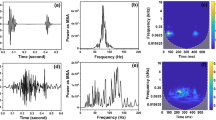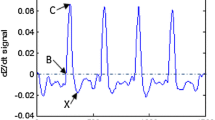Abstract
In this study, the correlation dimension analysis has been applied to the aortic valve Doppler signals to investigate the complexity of the Doppler signals which belong to aortic stenosis (AS) and aortic insufficiency (AI) diseases and healthy case. The Doppler signals of 20 healthy subjects, ten AS and ten AI patients were acquired via the Doppler echocardiography system that is a noninvasive and reliable technique for assessment of AS and AI diseases. The correlation dimension estimations have been performed for different time delay values to investigate the influence of time delay on the correlation dimension calculation. The correlation dimension of healthy group has been found lower those found in AI and AS disorder groups and the correlation dimension of AS group has also been found higher than those found in AI group, significantly. The results of this study have indicated that the aortic valve Doppler signals exhibit high level chaotic behaviour in AI and AS diseases than healthy case. Additionally, the correlation dimension analysis is sensitive to the time delay and has successfully characterized the blood flow dynamics for proper time delay value. As a result, the correlation dimension can be used as an efficient method to determine the healthy or pathological cases of aortic valve.







Similar content being viewed by others
References
Glass, L., and Kaplan, D. T., Time series analysis of complex dynamics in physiology and medicine. Med. Prog. Technol. 19:115, 1993.
Haykin, S., and Li, X. B., Detection of signals in chaos. Proc. IEEE. 83:95, 1995. doi:10.1109/5.362751.
Wagner, C. D., and Persson, P. B., Chaos in the cardiovascular system: an update. Cardiovasc. Res. 40:257, 1998. doi:10.1016/S0008-6363(98)00251-X.
Akay, M., Nonlinear biomedical signal processing, volume 2: dynamic analysis and modelling. IEEE Press Series on Biomedical Engineering, New York, 2000.
Stefanovska, A., and Bracic, M., Reconstructing cardiovascular dynamics. Control Eng. Pract. 7:161, 1999. doi:10.1016/S0967-0661(98)00185-3.
Otto, C. M., Valvular heart disease. W.B. Saunders, Pennsylvania, 1999.
Nishimura, R. A., Aortic valve disease. Circulation. 106:770, 2002. doi:10.1161/01.CIR.0000027621.26167.5E.
ACC/AHA, Practice guidelines for the management of patients with valvular heart disease: Executive Summary. A report of the American College of Cardiology/American Heart Association Task Force on Practice Guidelines (Writing committee to revise the 1998 guidelines fort he management of patients with valvular heart disease). J. Am. Coll. Cardiol. 48:598, 2006. doi:10.1016/j.jacc.2006.05.030.
DeGroff, C. G., Doppler echocardiography. Pediatr. Cardiol. 23:307, 2002. doi:10.1007/s00246-001-0196-7.
Hatle, L., and Angelsen, B., Doppler ultrasound in cardiology physical principles and clinical applications. Lea and Febiger, Philadelphia, USA, 1982.
Hoskins, P. R., McDiken, W. N., and Allan, P. L., Haemodynamics and blood flow. In: Allan, P. L., Dubbins, P. A., Pozniak, M. A., and McDiken, W. N. (Eds.), Clinical Doppler Ultrasound. London: Churchill Livingstone, p. 27, 2000.
Cannon, S. R., Richards, K. L., and Rollwit, W. T., Digital Fourier technique in the diagnosis and quantification of aortic stenosis with pulsed-Doppler echocardiography. J. Clin. Ultrasound. 10:101, 1982. doi:10.1002/jcu.1870100303.
Güler, İ., Kara, S., Güler, N. F., and Kiymik, M. K., Application of autoregressive and fast Fourier transform spectral analysis to tricuspid and mitral valve stenosis. Comput. Methods Programs Biomed. 49:29, 1996. doi:10.1016/0169-2607(95)01702-X.
Güler, İ., Hardalaç, F., and Müldür, S., Determination of aorta failure with the application of FFT, AR and wavelet methods to Doppler technique. Comput. Biol. Med. 32:435, 2001. doi:10.1016/S0010-4825(02)00021-5.
Turkoglu, I., Arslan, A., and Ilkay, E., An intelligent system for diagnosis of the heart valve diseases with wavelet packet neural networks. Comput. Biol. Med. 33:319, 2003. doi:10.1016/S0010-4825(03)00002-7.
Barişçi, N., Topal, E., Hardalaç, F., and Güler, İ., Classification of aorta insufficiency and stenosis using neuro-fuzzy system. J. Med. Syst. 29:155, 2005. doi:10.1007/s10916-005-3003-9.
Amit, G., Gavriely, N., Lessick, J., and Intrator, N., Automatic extraction of physiological features from vibro-acoustic heart signals: correlation with echo-Doppler, 32nd Annual International Conference on Computers in Cardiology 32, 299. Lyon, France, 2005.
Kara, S., Classification of mitral stenosis from Doppler signals using short time Fourier transform and artificial neural networks. Exp. Syst. Appl. 31:229, 2007.
Keunen, R. W. M., Vliegen, J. H. R., Stam, C. J., and Tavy, D. L., Nonlinear transcranial Doppler analysis demonstrates age-related changes of cerebral hemodynamics. Ultrasound Med. Biol. 22:383, 1996. doi:10.1016/0301-5629(96)00035-X.
Güler, İ., and Übeyli, E. D., Detecting variability of internal carotid arterial Doppler signals by Lyapunov exponents. Med. Eng. Phys. 26:763, 2004. doi:10.1016/j.medengphy.2004.06.007.
Ozturk, A., and Arslan, A., Classification of transcranial Doppler signals using their chaotic invariant measures. Comput. Methods Programs Biomed. 86:171, 2007. doi:10.1016/j.cmpb.2007.02.004.
Abarbanel, H. D. I., Brown, R., Sidorowich, J. J., and Tsimring, L. S., The analysis of observed chaotic data in physical systems. Rev. Mod. Phys. 65:1331, 1993. doi:10.1103/RevModPhys.65.1331.
Parlitz, U., Nonlinear time series analysis. In: Suykens, J. A. K., and Vandewalle, J. (Eds.), Nonlinear Modelling—Advanced Black-Box Techniques. Kluwer: Academic, p. 209, 1998.
Hentschel, H. G. E., and Procaccia, I., The infinite number of generalized dimensions of fractals and strange attractors. Physica D. 8:435, 1983. doi:10.1016/0167-2789(83)90235-X.
Grassberger, P., and Procaccia, I., Measuring the strangenes of strange attractors. Physica D. 9:189, 1983. doi:10.1016/0167-2789(83)90298-1.
Carvajal, R., Wessel, N., Vallverdu, M., Caminal, P., and Voss, A., Correlation dimension analysis of heart rate variability in patients with dilated cardiomyopathy. Comput. Methods Programs Biomed. 78:133, 2005. doi:10.1016/j.cmpb.2005.01.004.
Evans, D. H., McDicken, W. N., Skidmore, R., and Woodcock, J. P., Doppler ultrasound: physics, instrumentation and clinical applications. Chichester, Wiley, 1989.
Sigel, B., A brief history of Doppler ultrasound in the diagnosis of peripheral vascular disease. Ultrasound Med. Biol. 24:169, 1998. doi:10.1016/S0301-5629(97)00264-0.
Papadimitriou, S., and Bezerianos, A., Nonlinear analysis of the performance and reliability of wavelet singularity detection based denoising for Doppler ultrasound fetal heart rate signals. Int. J. Med. Inform. 53:43, 1999. doi:10.1016/S1386-5056(98)00102-6.
Zhang, Y., Wang, Y., Wang, W., and Liu, B., Doppler ultrasound signal denoising based on wavelet frames. IEEE Trans. Ultrason. Ferroelectr. Freq. Control. 48:709, 2001. doi:10.1109/58.920698.
Donoho, D. L., De-noising by soft-thresholding. IEEE Trans. Inf. Theory. 41:613, 1995. doi:10.1109/18.382009.
Daubechies, I., Ten lectures on wavelets. SIAM, Philadelphia, PA, 1992.
Donoho, D. L., and Johnstone, I. M., Ideal spatial adaptation via wavelet shrinkage. Biometrika. 81:425, 1994. doi:10.1093/biomet/81.3.425.
William, G. P., Chaos Theory Tamed. Taylor and Francis, London, 1997.
Takens, F., Detecting strange attractors in turbulence. Lect. Notes Math. 898:366, 1981. doi:10.1007/BFb0091924.
Fraser, A. M., and Swinney, H. L., Independent coordinates for strange attractors from mutual information. Phys. Rev. A. 33:1134, 1986. doi:10.1103/PhysRevA.33.1134.
Sauer, T., Yorke, J., and Casdagli, M., Embedology. J. Stat. Phys. 65:579, 1994. doi:10.1007/BF01053745.
Theiler, J., Estimating fractal dimension. J. Opt. Soc. Am. A. 7:1055, 1990. doi:10.1364/JOSAA.7.001055.
Merkwirth, C., Partliz, U., and Lauterborn, W., TSTOOL—A software package for nonlinear time series analysis. Proc. Int. Workshop on Advanced Black-Box Techniques for Nonlinear Modelling (Katholieke Universiteit, Leuven, Belgium, July 8–10) p. 144, 1998.
Ding, M., Grebogi, C., Ott, E., Sauer, T., and Yorke, J. A., Estimating correlation dimension from chaotic time series: when does plateau occur? Physica D. 69:404, 1993. doi:10.1016/0167-2789(93)90103-8.
Eckmann, J. P., and Ruelle, D., Fundamental limitations for estimating dimensions and Lyapunov exponents in dynamical systems. Physica D. 56:185, 1992. doi:10.1016/0167-2789(92)90023-G.
Kantz, H., and Schreiber, T., Nonlinear time series analysis, 2nd edition. Cambridge University Press, Cambridge, 2003.
May, P., Arrouvel, C., Revol, M., Servant, J. M., and Vicaut, E., Detection of hemodynamic turbulence in experimental stenosis: an in vivo study in the rat carotid artery. J. Vasc. Res. 39:21, 2002. doi:10.1159/000048990.
Parthimos, D., Osterloh, K., Pires, A. R., and Griffith, T. M., Deterministic nonlinear characteristics of in vivo blood flow velocity and arteriolar diameter fluctuations. Phys. Med. Biol. 49:1789, 2004. doi:10.1088/0031-9155/49/9/014.
Almog, Y., Oz, O., and Akselrod, S., Correlation dimension estimation: Can this nonlinear description contribute to the characterization of blood pressure control in rats? IEEE Trans. Biomed. Eng. 46:535, 1999. doi:10.1109/10.759054.
Theiler, J., Statistical precision of dimension estimators. Phys. Rev. A. 41:3038, 1990. doi:10.1103/PhysRevA.41.3038.
Young, J. B., Quinones, M. A., Waggoner, A. D., and Miller, R. R., Diagnosis and quantification of aortic stenosis with pulsed Doppler echocardiography. Am. J. Cardiol. 45:987, 1980. doi:10.1016/0002-9149(80)90167-8.
Yearwood, T. L., Misbach, G. A., and Chandran, K. B., Experimental fluid dynamics of aortic stenosis in a model of human aorta. Clin. Physiol. Meas. 10:11, 1989. doi:10.1088/0143-0815/10/1/002.
Ruelle, D., and Takens, F., On the nature of turbulence. Commun. Math. Phys. 20:167 and 23, 343, 1971.
Barclay, K. D., Klassen, G. A., and Young, C., A method for detecting chaos in canine myocardial microcirculatory red cell flux. Microcirculation. 7:335, 2000. doi:10.1038/sj.mn.7300116.
Schulz, S., Bauernschmitt, R., Schwarzhaupt, A., Vahl, C. F., and Kiencke, U., Nonlinear dynamic analysis of hemodynamic signals for identifying transitions between ventriculoarterial coupling states. Comput. Cardiol. 26:507, 1999.
Acknowledgement
The authors would like to thank Prof. Dr. N. Kürşad Tokel the cardiologist of Pediatric Cardiology Department of Başkent University Ankara Hospital for recording data and his contributions.
Author information
Authors and Affiliations
Corresponding author
Rights and permissions
About this article
Cite this article
Yılmaz, D., Güler, N.F. Correlation Dimension Analysis of Doppler Signals in Children with Aortic Valve Disorders. J Med Syst 34, 931–939 (2010). https://doi.org/10.1007/s10916-009-9308-3
Received:
Accepted:
Published:
Issue Date:
DOI: https://doi.org/10.1007/s10916-009-9308-3




